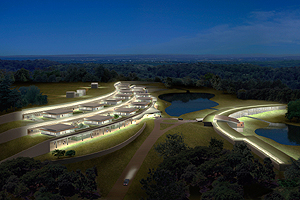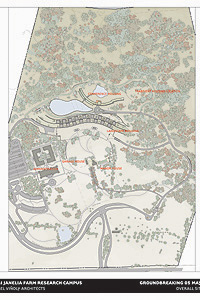University, HHMI join forces to train graduate students in biosciences
By Catherine GianaroMedical Center Public Affairs
 An architectural rendering of Janelia Research Farm, which is being built in Virginia, shows a view of the facility at night. Rafael Viñoly Architects, who designed the University’s Graduate School of Business Hyde Park Center, are designing the group of buildings. | |
The University is partnering with the Howard Hughes Medical Institute to jointly train graduate students at Chicago and HHMI’s future $500 million Janelia Farm Research Campus in Virginia. As a result of this new partnership, the Biological Sciences Division will become the only American “access point” to this joint program, with Cambridge University providing the European access.
“We expect this novel arrangement to attract a good deal of interest from a very select group of highly focused, self-directed and well-prepared graduate students,” said James Madara, Dean of the BSD and Vice President for Medical Affairs. “It opens up a whole new set of resources for our students and provides new opportunities for scientific imagination and collaboration.”
The joint training partnership between the University and HHMI will be administered through Chicago’s new Interdisciplinary Scientist Training Program. The program, which HHMI investigator Harinder Singh, the Louis Block Professor in Molecular Genetics & Cell Biology, will lead, will feature flexible training and diverse faculty participation, and will grant students the Ph.D. in biology.
“As biologists we are always drawn to bold, innovative experiments and, thus, are delighted with this collaboration with HHMI, which fits squarely into such a category,” Madara said.
The program will aim to attract a small number of outstanding graduate students who will benefit from doing their Ph.D. research in the collaborative, interdisciplinary environment.
HHMI recently began its second round of recruitment for Janelia Farm group leaders, who are independent scientists similar to the HHMI investigators based at universities and independent research institutes. This second phase of recruitment follows the appointment of seven group leaders earlier this year.
Scientists recruited to Janelia Farm so far include Gene Myers, currently professor of computer science at the University of California, Berkeley. Myers, who as Vice President of Informatics Research at Celera Genomics in the late 1990s, developed the algorithms behind the successful sequencing of the human genome. Also recruited are two senior fellows—molecular biologist and Nobel laureate Sydney Brenner and Charles Shank, former director of the Lawrence Berkeley National Laboratory.
 | |
As HHMI’s first freestanding campus, Janelia Farm will provide a setting where small research groups can explore fundamental biomedical questions in a highly collaborative, interdisciplinary culture. When it opens in the summer of 2006, there will be 20 to 30 group leaders and a permanent research staff of about 300 scientists who will work toward two main goals: identifying the general principles that govern how information is processed by neuronal circuits, and developing imaging technologies and computational methods for image analysis.
It is expected that the small size of the research groups and the highly interactive culture planned for Janelia Farm will provide a strong training and mentoring environment for graduate students. “At the same time, Ph.D. students will add to the vitality of Janelia Farm, as these individuals often provide a unique perspective, communicating across unexpected lines and initiating innovative avenues of collaborative research,” said Kevin Moses, associate director for science and training of the Janelia Farm Research Campus.
The partnership program between Chicago, HHMI and Cambridge will enable students to benefit from Janelia Farm’s research environment as well as the universities’ academic resources, while fostering interaction between scientists at all three institutions. HHMI and BSD are also exploring ways to provide short-term training opportunities at Janelia Farm for graduate, joint-degree and undergraduate students.
Each student will have two advisers: a Janelia Farm group leader and a faculty member at the partner university in which the student is enrolled. Together, the advisers and student will develop an individual education plan for the student. The two universities will provide the academic training required to support this interdisciplinary program, from mathematics and computer science to physics, chemistry and biology.
Students generally will spend their first year at the university pursuing academic courses and/or collaborative research projects, then spend the remaining years of their graduate research at Janelia Farm. Students are expected to earn a Ph.D. degree in four to five years.
The first class of graduate students will enter the program in the fall of 2007, following recruitment during the 2006-2007 academic year. Janelia Farm group leaders and faculty representatives of Chicago and Cambridge will interview applicants at the Virginia research campus. Successful applicants will be admitted to either university and to a particular research group at Janelia Farm. The partner university in which a student is enrolled will award the Ph.D.
![[Chronicle]](/images/sidebar_header_oct06.gif)